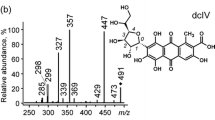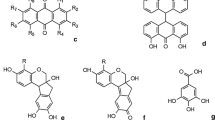Abstract
Organic colorants contained in 30 textiles (16th to early 20th century) from the monastery of Simonos Petra (Mount Athos) have been investigated using high-performance liquid chromatography equipped with diode-array detection and mass spectrometry (HPLC–DAD–MS). The components of natural dyes identified in samples treated by the standard HCl dyestuff extraction method were: alizarin, apigenin, butein, carminic acid, chrysoeriol, dcII, dcIV, dcVII, ellagic acid, emodin, fisetin, flavokermesic acid, fustin, genistein, haematein derivative (Hae′), indigotin, indirubin, isoliquiritigenin, isorhamnetin, kaempferide, kaempferol, kermesic acid, luteolin, naringenin, purpurin, quercetin, rhamnazin, rhamnetin, sulfuretin, and type B and type C compounds (last two are markers for Caesalpinia trees). Early, semi-synthetic dyes, for example indigo carmine, fuchsin components, and rhodamine B were identified in objects dated late 19th to early 20th century. A dyestuff extraction method which involves use of TFA, instead of HCl, was applied to selected historical samples, showing that the mild method enables efficient extraction of weld (Reseda luteola L.) and dyer’s broom (Genista tinctoria L.) glycosides. The marker compound (Hae′) for logwood (Haematoxylum campechianum L.) identification after treatment with HCl was investigated by liquid chromatography coupled to mass spectrometry (LC–MS) in negative electrospray ionization (LC–MS-ESI−) mode. LC–MS in negative atmospheric pressure chemical ionization (LC–MS-APCI−) mode was used, probably for the first time, to investigate cochineal (Dactylopius coccus Costa) samples. Positive electrospray ionization (LC–MS-ESI+) mode was used for identification of fuchsin components. Detailed HPLC–DAD studies were performed on young fustic (Cotinus coggygria Scop.) and Persian berries (Rhamnus trees).






Similar content being viewed by others
References
Cardon D (2007) Natural dyes—sources, tradition, technology and science. Archetype, London
Hofenk-de Graaff JH (2004) The colourful past: origins, chemistry and identification of natural dyestuffs. Archetype, London
Karapanagiotis I (2006) Am Lab 38:36–40
Wilkins J, Hill S (2006) Food in the ancient world. Blackwell publishing, Malden, MA
Osbourn AE, Lanzotti V (2009) Plant-derived natural products: synthesis, function and applications. Springer, Berlin Heidelberg New York
Papageorgiou VP, Assimopoulou AN, Couladouros EA, Hepworth D, Nicolaou KC (1999) Angew Chem Int Ed 38:270–300
Karapanagiotis I, Lakka A, Valianou L, Chryssoulakis Y (2008) Microchim Acta 160:477–483
Valianou L, Stathopoulou K, Karapanagiotis I, Magiatis P, Pavlidou E, Skaltsounis A-L, Chryssoulakis Y (2009) Anal Bioanal Chem 394:871–882
Wouters J (1985) Stud Conserv 30:119–128
Surowiec I, Nowik W, Trojanowicz M (in press) Dyes History Archaeol 22
Zhang X, Laursen RA (2005) Anal Chem 77:2022–2025
Sanyova J, Reisse J (2006) J Cult Herit 7:229–235
Marques R, Sousa MM, Oliveira MC, Melo MJ (2009) J Chromatogr A 1216:1395–1402
Valianou L, Karapanagiotis I, Chryssoulakis Y (2009) Anal Bioanal Chem 395:2175–2189
Rosenberg E (2008) Anal Bioanal Chem 391:33–57
Petroviciu I, Albu F, Medvedovici A (2010) Microchem J 95:247–254
Hulme AN, McNab H, Peggie DA, Quye A, Vanden Berghe I, Wouters J (2005) ICOM 14th Triennial Meeting The Hague: 12–16 September 2005: Preprints, vol II. Earthscan Publications Ltd., London, U.K., p 783
Lyon H, Schulte E, de Leenheer A, Lewis S, Friemert V, Struck C, Gadsdon D, Allison R, Brunk U, van Liederkerke B, Hasselager E, Horobin R, Husain O, Wittekind D, Zschoch H (1992) Histochem J 24:236–237
Peggie DA, Hulme AN, McNab H, Quye A (2008) Microchim Acta 162:371–380
Karapanagiotis I, Minopoulou E, Valianou L, Sister Daniilia, Chryssoulakis Y (2009) Anal Chim Acta 647:231–242
Valianou L, Wei S, Mubarak MS, Farmakalidou L, Karapanagiotis I, Rosenberg E, Stassinopoulos S (2010) J Archaeolog Sci, In press doi:10.1016/j.jas.2010.08.025
Assimopoulou AN, Karapanagiotis I, Vasiliou A, Kokkini S, Papageorgiou VP (2006) Biomed Chromatogr 20:1359–1374
Nowik W (2001) Dyes Hist Archaeol 16/17:129–144
Antal DS, Schwaiger S, Ellmerer-Müller EP, Stuppner H (2010) Planta Med 76:1–8
Wouters J (2001) Dyes History Archaeol 16/17:145–157
Ferreira E, Quye A, McNab H, Hulme A (2003) Dyes History Archaeol 19:19–23
Puchalska M, Połeć-Pawlak K, Zadrożna I, Hryszko H, Jarosz M (2004) J Mass Spectrom 39:1441–1449
Van Bommel MR, Vanden Berghe I, Wallert AM, Boitelle R, Wouters J (2007) J Chromatogr A 1157:260–272
Acknowledgements
The authors would like to thank Dr C. Karydis for providing the historical samples. Support by the Getty Foundation (USA), through the project Byz-tex-Athos (www.byztexathos.org) is gratefully acknowledged.
Author information
Authors and Affiliations
Corresponding author
Additional information
Published in the special issue Analytical Chemistry for Cultural Heritage with Guest Editors Rocco Mazzeo, Silvia Prati, and Aldo Roda.
Rights and permissions
About this article
Cite this article
Mantzouris, D., Karapanagiotis, I., Valianou, L. et al. HPLC–DAD–MS analysis of dyes identified in textiles from Mount Athos. Anal Bioanal Chem 399, 3065–3079 (2011). https://doi.org/10.1007/s00216-011-4665-4
Received:
Revised:
Accepted:
Published:
Issue Date:
DOI: https://doi.org/10.1007/s00216-011-4665-4




